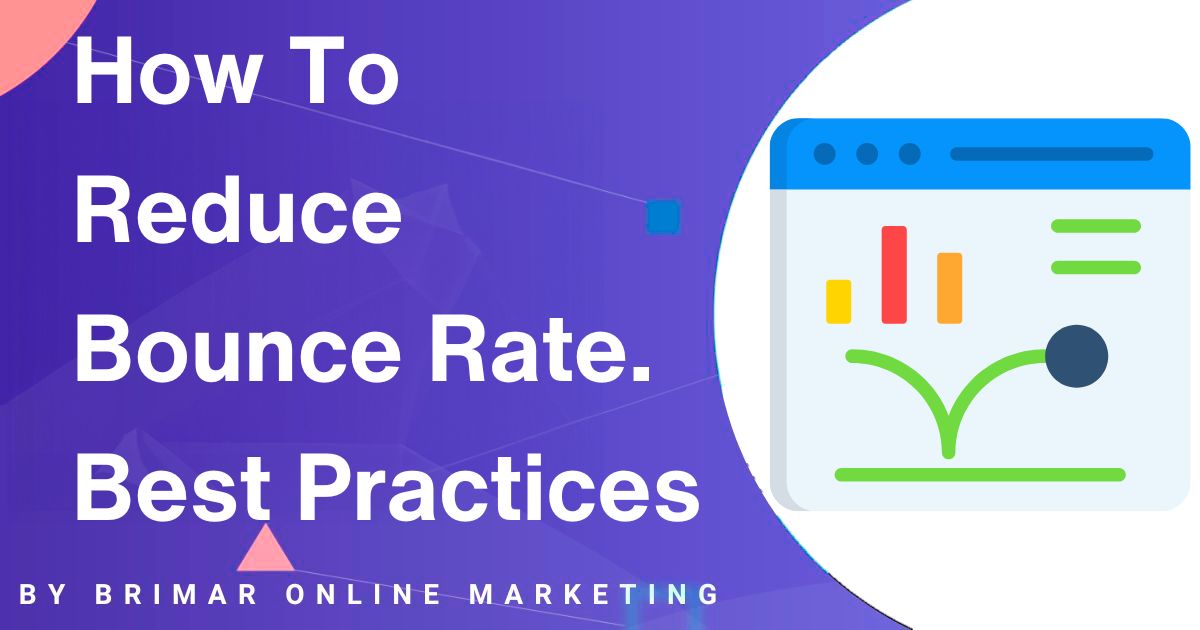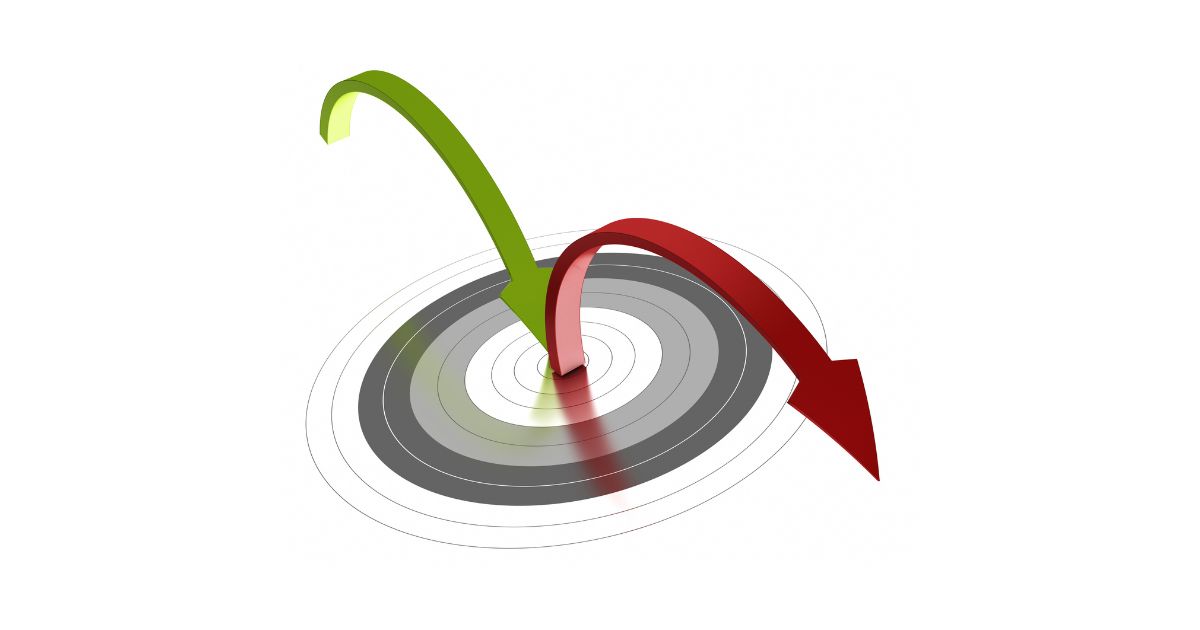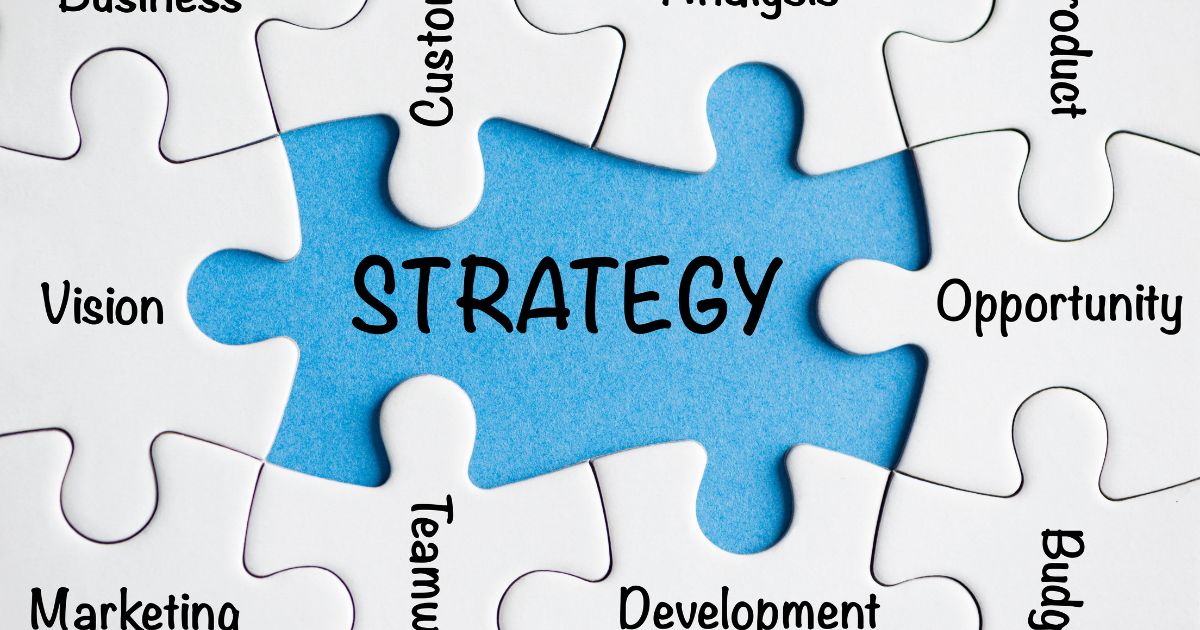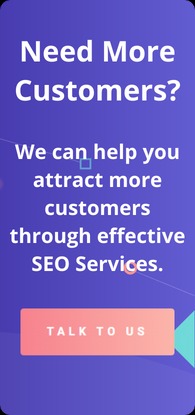
Understanding your website’s bounce rate might seem like just another thing on the endless list of things to monitor, but it’s actually one of the most telling metrics out there.
So, what exactly is the bounce rate?
Simply put, it’s the percentage of visitors who land on a specific page of your site and then leave without interacting further.
No clicks, no scrolling, nothing.
They came, they saw, and they bounced.
Now, why should you care?
Because a high bounce rate is like having people walk into your store, glance around for a second, and then walk right back out.
Not great for business, right?
The same goes for your website.
If folks are leaving before they even engage with your content, it’s a clear signal that something’s off, whether it’s the content, the layout, or maybe even how fast your site loads.
Understanding and improving your bounce rate is crucial for two big reasons: user engagement and conversions.
The longer someone sticks around on your site, the more likely they are to interact with your content, explore what you offer, and eventually become a customer.
That’s where the magic happens.
Google Analytics is your best friend when it comes to tracking and analyzing bounce rates.
It gives you the hard data you need to figure out where visitors are dropping off and what might be causing it.
Are your landing pages not delivering what they promised?
Is your site speed sluggish?
Are mobile users having a tough time navigating?
Google Analytics can help you answer all these questions and more, guiding you toward actionable steps to keep those visitors engaged and coming back for more.
So, keeping an eye on your bounce rate isn’t just about numbers;
it’s about understanding your audience, improving their experience, and ultimately boosting your business’s bottom line.
Understanding Bounce Rate
What is Bounce Rate?
Let’s break down what bounce rate actually means.
When someone visits your website and leaves without exploring any other pages, that’s considered a “bounce.”
It’s like walking into a store, looking around for a moment, and then heading right back out the door.
The percentage of these one-and-done visits is what we call the bounce rate.
Now, not all bounces are bad, but when a high percentage of your visitors are bouncing, that’s where you might have a problem.
A high bounce rate could suggest that people aren’t finding what they’re looking for or, worse, that something on your site is driving them away.
On the flip side, a low bounce rate indicates that visitors are sticking around, engaging with your content, and exploring multiple pages.
So, what’s a good bounce rate?
The decision greatly depends on the nature of your website.
For example, blogs typically see higher bounce rates because people often come for a specific post and leave after reading it.
However, eCommerce sites usually aim for a lower bounce rate since you want visitors to browse products, add items to their cart, and eventually make a purchase.
At the end of the day, the bounce rate metric is a crucial indicator of your website’s performance.
It gives you a quick snapshot of how well your site is meeting the expectations of your visitors.
Start Attracting Customers Through SEO Today!
We can help you attract new customers through Tailored Search Engine Optimization Strategies for Your Business.
Why is Bounce Rate Important?
You might be wondering why you should care about your bounce rate?
Well, it plays a significant role in how search engines like Google view your site.
A higher bounce rate can be a signal to Google that your site might not be providing the best experience for users, which can negatively affect your search rankings.
This means your site might not show up as high in search results, leading to less organic traffic.
But it’s not just about search rankings.
A high bounce rate can also hurt your conversion rate.
If people are leaving your site quickly, they’re not sticking around long enough to make a purchase, sign up for your email list, or complete any other conversion event you’ve set up.
This can throw a wrench in your entire digital marketing strategy.
Different types of websites will experience bounce rates differently.
For eCommerce sites, a high bounce rate on product pages might mean your product descriptions aren’t compelling enough or that your site’s navigation is confusing.
For blogs, if people are bouncing after reading one post, you might need to work on your internal links to keep them exploring more of your content.
Common Causes of a High Bounce Rate
When it comes to keeping visitors on your website, understanding the factors that cause them to leave quickly is crucial.
A high bounce rate often points to specific issues that can be addressed to improve user engagement and, ultimately, conversions.
Let’s dive into some of the most common culprits behind a high bounce rate.
Poor User Experience
A poor user experience is like inviting someone to your home and then making them stand in the doorway because your furniture blocks the way.
Site speed is one of the most significant factors here.
If your pages take too long to load, especially on mobile devices, visitors are likely to hit the back button before they even see your content.
The expectation today is that a website should load almost instantly.
A delay of just a few seconds can drastically increase your bounce rate.
Mobile responsiveness is another critical aspect.
With more people browsing on their phones than ever, your website must look and function well on different devices and screen sizes.
A non-responsive design that’s hard to navigate on a smartphone or tablet is a major turn-off.
If your site doesn’t automatically adjust to fit smaller screens, you’re essentially telling mobile users they’re not your priority leading them to bounce.
White space, or rather the lack of it, also plays a big role.
A cluttered page overwhelms visitors, making it hard for them to find what they’re looking for.
On the other hand, well-used white space guides the eye, helps prioritize content, and creates a more pleasant browsing experience.
Irrelevant Content
Relevance is key.
When visitors land on your page, they’re looking for specific information.
If your content doesn’t match their search intent, they’re going to leave.
It’s that simple.
Providing outdated or off-topic content not only frustrates visitors but also increases your exit rates.
This is where your meta descriptions and keywords come into play.
These elements help search engines understand what your page is about and ensure that the right people find it.
If your meta descriptions are misleading or your keywords are off the mark, you’ll attract the wrong audience; people who aren’t interested in what you have to offer.
This mismatch can lead to visitors leaving as quickly as they arrive.
Technical Issues
Technical issues can be silent killers for your bounce rate.
Slow page load times are a prime example.
If your website takes too long to load, visitors will lose patience and leave before they even see what you have to offer.
Even worse, problems with your content delivery network (CDN) can slow things down further, especially for users in different geographic locations.
Then there are hard bounces, where users can’t access your site at all due to server errors or broken links.
These are clear indicators of technical problems that need immediate attention. Web analytics tools can be invaluable here.
By digging into your site’s performance data, you can identify and fix these issues, ensuring a smoother experience for your visitors.
Lastly, consider the impact of disruptive elements like aggressive display ads or poorly implemented pop-ups.
While ads are a common revenue stream, they shouldn’t come at the cost of a good user experience.
Ads that take too long to load or pop-ups that interrupt the browsing flow can easily drive visitors away, adding to your bounce rate.
By focusing on these areas; user experience, relevant content, and technical performance;
you can address the root causes of a high bounce rate and create a more inviting and engaging environment for your visitors.
4 Best Practices to Lower Bounce Rate

1. Improve User Experience
Responsive Design
Your website should feel like it was made just for the device your visitor is using, whether it’s a smartphone, tablet, or desktop.
Responsive design isn’t just a nice-to-have; it’s a must.
When your site adapts perfectly to different screen sizes, visitors can easily browse and interact, reducing the chances they’ll leave after just one glance.
Site Speed
We’ve all been there; waiting for a website to load and finally giving up.
Slow websites are a surefire way to push visitors away.
A fast-loading site isn’t just about convenience; it’s about keeping people engaged.
Speed up your site by optimizing images, leveraging content delivery networks (CDNs), and minimizing unnecessary scripts.
The quicker your site loads, the more likely visitors will stick around and explore.
Easy Navigation
Think of your website as a road map.
You want to guide your visitors to the best spots without them getting lost.
Clear call-to-actions (CTAs) and well-placed internal links help users find exactly what they’re looking for.
When navigation is simple and intuitive, people are more likely to stay, explore, and convert.
2. Optimize Content for Relevance
Creating Relevant Content
Content is king, but only if it’s relevant.
Your content should speak directly to the needs and interests of your audience.
Making sure your content aligns with search intent is extremely important.
When visitors find the exact information they’re searching for, they’re less likely to bounce and more likely to engage further with your site.
Using Video Content
Video content is a compelling tool for engaging your audience.
It’s engaging, easy to consume, and can keep visitors on your page longer.
Incorporate videos that are relevant to your content and see how your bounce rate starts to drop as engagement increases.
Adding Trust Signals
Trust is everything online.
When visitors see customer reviews, certifications, or any form of trust signals, they feel more confident in your website.
This added credibility can be the difference between a visitor staying to learn more or bouncing off to a competitor.
3. Enhance Page Design
Clear Call-to-Actions
Your CTAs should be like friendly guides, leading visitors exactly where you want them to go.
Whether it’s on landing pages or blog posts, placing CTAs strategically ensures visitors don’t just wander aimlessly; they take action.
A well-placed CTA can drive conversions and keep visitors engaged.
Effective Use of White Space
Sometimes less is more.
White space isn’t wasted space; it’s breathing room for your content.
It helps your visitors focus on what’s important without feeling overwhelmed.
A clean, uncluttered design makes your site more inviting and easier to navigate, encouraging visitors to stay longer.
Bullet Points and Lists
People love content that’s easy to scan.
Bullet points and lists are a great way to break down information into digestible bites.
This not only makes your content more accessible but also helps visitors quickly find what they’re looking for, reducing the chances they’ll bounce.
4. Use of A/B Testing
A/B Testing
Sometimes, the best way to find what works is to test it.
A/B testing allows you to try different versions of your page elements;
like headlines, CTAs, or layouts and see which one resonates better with your audience.
This hands-on approach helps you fine-tune your site to lower your bounce rate effectively.
Analyzing Results
After A/B testing, don’t just sit back—analyze your results.
Use Google Analytics to track what’s working and what isn’t.
This data-driven approach helps you make informed decisions, ensuring your efforts to reduce bounce rate are actually paying off.
It’s all about continuous improvement and adapting to what your visitors need.
Strategies for Different Types of Websites

For Blogs and Content Sites
When running a blog or content site, keeping readers engaged and reducing bounce rates is all about making it easy for them to find what they’re looking for and then giving them a reason to stick around.
Internal Linking
Think of internal links as a friendly guide, pointing readers to other articles that might catch their interest.
It’s a simple yet powerful way to keep them exploring your site rather than clicking away.
If someone’s reading about “How to Reduce Bounce Rate,” they might also be interested in “Best Practices for On-Page SEO.”
A well-placed link can make that connection for them.
Table of Contents
For longer articles, a table of contents can be a lifesaver.
It gives readers a clear overview and helps them jump to the sections that matter most to them.
This is especially useful if your content is detailed and covers multiple subtopics; nobody likes to scroll endlessly to find the info they need.
Exit-Intent Popups
When it comes to capturing email sign-ups, exit-intent popups are like your last chance to make a connection before a visitor leaves.
These popups appear just as someone’s about to close the tab, offering a compelling reason to stay in touch, like a free guide or a special offer.
Done right, they can turn a one-time visitor into a long-term subscriber.
For eCommerce Sites
Running an eCommerce site comes with its own set of challenges, particularly when it comes to bounce rates.
Your goal is to make the shopping experience as smooth as possible so that visitors are more likely to make a purchase.
- Focus on Product Pages: Your product pages are where the magic happens—or doesn’t.
Make sure they’re not just visually appealing but also packed with all the info a shopper might need.
High-quality images, detailed descriptions, and customer reviews can make all the difference in whether a visitor stays or bounces. - Site Search Functionality: A robust site search feature is essential for helping users quickly find what they want.
Think about it—if someone lands on your site looking for a specific product but can’t easily find it, they’re likely to leave.
A well-functioning search bar with predictive text or filters can drastically improve user experience and keep bounce rates low. - Mobile Optimization: With more and more shoppers using their phones, having a mobile-optimized site isn’t just nice to have; it’s essential.
Mobile users often behave differently, and they expect a site that loads quickly, is easy to navigate, and doesn’t require endless zooming and pinching.
If your mobile site is clunky or slow, you’re likely losing potential customers.
For Lead Generation Sites
For sites focused on lead generation, the key is to guide visitors toward taking that all-important next step,
whether it’s signing up for a newsletter, downloading a free resource, or requesting a consultation.
- Clear, Compelling CTAs: Your call-to-actions (CTAs) should be like signposts, clearly guiding visitors toward what you want them to do.
Whether it’s a bold button that says “Get Your Free Quote” or a banner encouraging visitors to “Download Our Free eBook,” a well-placed and well-worded CTA can significantly boost conversions. - Free Trials and Demos: Offering a free trial or demo can be a fantastic way to lower bounce rates.
People love to try before they buy, and giving them a taste of what you offer can be just what they need to take the plunge.
This tactic not only keeps them engaged but also builds trust. - Building an Email List: Finally, never underestimate the power of a strong email list.
Opt-in forms on high-traffic pages, especially those offering something of value in exchange (like an exclusive discount or valuable resource), can turn casual visitors into leads.
Once you have their email, you can continue the conversation, reducing the likelihood of a bounce in future interactions.
Each of these strategies is tailored to the specific needs of different types of websites,
ensuring that no matter what kind of site you run, you can keep your visitors engaged and reduce your bounce rate effectively.
Tools and Techniques to Track and Reduce Bounce Rate
Using Web Analytics Tools
When it comes to understanding how well your website is performing, web analytics tools are your best friend.
They offer insights that go beyond surface-level data, helping you get to the heart of what’s really happening when visitors land on your site.
Google Analytics – Your Go-To Tool
Google Analytics is like the Swiss Army knife of web analytics.
It doesn’t just track how many people visit your site; it dives deep into how they interact with your content.
One of the most valuable metrics it offers is bounce rate.
This simple percentage tells you how many people left your site after viewing just one page.
But it’s more than just a number; it’s a window into your visitors’ experience.
Keep an Eye on User Engagement
User engagement is another crucial metric that Google Analytics helps you monitor.
This includes tracking single-page sessions, where visitors land on one page and then leave without exploring further.
If your single-page sessions are high, it’s a sign that something might be off.
Maybe your content isn’t engaging enough, or perhaps it’s not what the visitor expected based on their search query.
Spotting High Bounce Rates – A Goldmine for Improvement
Analyzing which pages have the highest bounce rates can reveal significant opportunities for improvement.
Are certain pages failing to meet visitor expectations?
Is the content relevant and engaging?
By identifying these pain points, you can make targeted changes to reduce your bounce rate and keep visitors on your site longer.
Implementing Advanced Strategies

Speed Up Your Site with CDNs
One of the quickest ways to lose a visitor is with a slow-loading page.
Nobody likes waiting around, especially in today’s fast-paced online world.
Content Delivery Networks (CDNs) can help by distributing your content across multiple servers around the globe, ensuring your site loads quickly no matter where your visitors are.
Faster load times can lead to a lower bounce rate and happier visitors.
Understand Your Traffic Sources
Not all traffic is created equal.
By leveraging web analytics, you can see where your visitors are coming from; whether it’s organic search, social media, or paid ads.
Understanding these sources can help you tailor your content and marketing strategies to reduce bounce rates from specific channels.
For example, if visitors from search engines are bouncing more than those from social media, it might be time to revisit your SEO strategy.
Keep Visitors Engaged with External Links and Relevant Content
One of the easiest ways to keep people on your site is to provide them with valuable, relevant content that answers their questions or solves their problems.
Use external links wisely to guide visitors to additional resources, but make sure the majority of your content keeps them engaged with your site.
Internal linking is also crucial; by connecting related content within your site, you encourage visitors to explore further, reducing the likelihood they’ll bounce away.
Final Thoughts
Keeping an eye on your website’s bounce rate isn’t just a good idea; it’s essential.
When visitors quickly leave your site, it’s a clear sign that something isn’t quite right.
Whether it’s slow load times, a lack of relevant content, or a poor mobile experience,
these issues can drive users away, hurting your overall performance and conversion rates.
Understanding and reducing bounce rate is like giving your website a tune-up.
It’s about ensuring that your site delivers what visitors are looking for in a way that’s easy to navigate and engaging enough to keep them around.
By focusing on the factors we’ve discussed (site speed, responsive design, relevant content, and clear navigation) you can create a more welcoming environment that encourages users to stay longer and explore more.
If you haven’t already, now’s the perfect time to dive into Google Analytics and get a clear picture of your current bounce rate.
This is your starting point.
From there, apply the best practices we’ve covered and watch how small changes can lead to big improvements.
Remember, it’s not just about lowering numbers; it’s about enhancing the overall experience for your visitors.
Feeling a bit overwhelmed with all the tips and strategies?
No worries!
That’s where we come in.
At Brimar Online Marketing, we specialize in helping businesses like yours turn their websites into engaging, conversion-focused platforms.
If you’re ready to take control of your bounce rate and optimize your site for better performance, we’re here to help.
Reach out to us for a personalized analysis of your website’s bounce rate.
Together, we’ll pinpoint the areas that need attention and craft a strategy that fits your goals.
Let’s transform your site into a space that not only attracts visitors but keeps them coming back for more.
Ready to get started?
Contact Brimar Online Marketing today, and let’s make your website the best it can be!
Our SEO Services Have Helped Our Clients Increase Their Revenue!
“I highly recommend Brimar if your looking to grow your online business. You will be satisfied with the high level of expertise and high quality of services. It has helped my business grow by leaps and bounds.”
CEO

